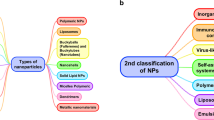Scott, N.R., 2007. Nanoscience in veterinary medicine. Veterinary Research Communications, 31(Suppl. 1), 139–144
ABSTRACT
Nanotechnology, as an enabling technology, has the potential to revolutionize veterinary medicine. Examples of potential applications in animal agriculture and veterinary medicine include disease diagnosis and treatment delivery systems, new tools for molecular and cellular breeding, identity preservation of animal history from birth to a consumer’s table, the security of animal food products, major impact on animal nutrition scenarios ranging from the diet to nutrient uptake and utilization, modification of animal waste as expelled from the animal, pathogen detection, and many more. Existing research has demonstrated the feasibility of introducing nanoshells and nanotubes into animals to seek and destroy targeted cells. Thus, building blocks do exist and are expected to be integrated into systems over the next couple of decades on a commercial basis. While it is reasonable to presume that nanobiotechnology industries and unique developments will revolutionize veterinary medicine in the future, there is a huge concern, among some persons and organizations, about food safety and health as well as social and ethical issues which can delay or derail technological advancements.
Similar content being viewed by others
REFERENCES
Drexler E.K., 1986. Engines of Creation – The Coming Era of Nanotechnology, (Archer Books, New York)
Drexler E.K., Peterson C. and Pergamit G., 1991. Unbounding the Future: The Nanotechnology Revolution, (William Morrow and Company, New York)
ETC Group, 2004. Down on the Farm: The Impact of Nano-scale Technologies on Food and Agriculture. Ottawa, ON, Canada, 68. (download available at www.etcgroup.org)
Feneque J., 2003. Brief Introduction to the Veterinary Applications of Nanotechnology. Nanotechnology Now, (www.nanotech-now.com/Jose-Feneque/Veterinary -Applications-Nanotechnology.htm)
Feynman R., 1961. There’s Plenty of Room at the Bottom. In: Gilbert H.D. (ed), Miniaturization, (Rheinhold, NY), 282–296
Gordijn B., 2003. Nanoethics: From Utopian Dreams and Apocalyptic Nightmares towards a more Balanced View. Third Session of World Commission on Ethics of Scientific Knowledge and Technology (COMEST), 1–4 December, Rio de Janeiro, Brazil, 12
Hirsch L.R., Gobin A.M., Lowery A.M., Drezek R.A., Halas N.J. and West J.L., 2006. Metal Nanoshells. Annals of Biomedical Engineering, 34(1), 15–22
Kahn J., 2006. Nano’s Big Future. National Geographic, 209(6), 96–119
Kan E., 2006. Implantable Miniature Sensors to Monitor Blood Flow. Technology News Daily, (http://www.technologynewsdaily.com/taxonomy/term/24?page=6)
Li Y., Cu Y.T.H. and Luo D., 2005. Multiplexed detection of pathogen DNA with DNA-based fluorescence nanobarcodes. Nature Biotechnology, 23, 885–889
National Science and Technology Council, 1999. Nanotechnology: Shaping the World Atom by Atom. Committee on Technology, (Interagency Working Group on Nanoscience, Engineering and Technology, Washington, DC, USA). (www.ostp.gov/NSTC/html/iwgn/iWGN.Public.Brochure/welcome.htm)
National Science and Technology Council, 2004. National Nanotechnology Initiative. Committee on Technology. Subcommittee on Nanoscale Science, Engineering and Technology. Supplement to the President’s FY 2004 Budget. (www.ostp.gov/NSTC/html/iwgn/iwgn.fy04budsupporl/toc.htm)
O’Connell M.J., Bachilo S.M., Huffaman C.B., Moore V.C. and Strano M.S., 2002. Band Gap Fluorescence from Individual Single-Walled Carbon Nanotubes. Science, 298, 2361–2366
Scott N.R., 2005. Nanotechnology and Animal Health. OIE Scientific and Technical Review, 24(1), 425–432
Scott N.R. and Chen H., 2002. Nanoscale Science and Engineering for Agriculture and Food Systems. National Planning Workshop. Washington DC, USA, 18–19 November. (www.nseafs.cornell.edu)
Vogel V. and Baird B. (Eds), 2003. Nanobiotechnology. Report of the National Nanotechnology Initiative Workshop, 9–11 October, Arlington, VA, USA
Author information
Authors and Affiliations
Corresponding author
Rights and permissions
About this article
Cite this article
Scott, N.R. Nanoscience in Veterinary Medicine. Vet Res Commun 31 (Suppl 1), 139–144 (2007). https://doi.org/10.1007/s11259-007-0083-7
Published:
Issue Date:
DOI: https://doi.org/10.1007/s11259-007-0083-7




